How to Dismantle Old Barns
Old barns can be seen all over the countryside. Barns are designed to withstand the elements. If well cared for, a barn can easily last 100 years. But, according to the National Park Service, once the roof starts to go, moisture and rot get into the support framing and the entire structure becomes unsafe.

Things You Will Need
- Hammer
- Crow bar
- Chain with hook, 50 feet
- Chain saw
- Tractor
- Rake
- Grass seed
But that doesn't mean that the barn's life is over. Companies all over the world use antique barn wood for everything from furniture and paneling to custom-made artwork. The pulleys, hinges and other architectural pieces make great accent pieces.
-
Remove any loose or rotting pieces from the barn. This includes siding, floorboards and roofing material. Pay careful attention to any pieces that might fall on workers as they dismantle the barn.
-
Remove the windows, doors and any interior gates or closures. Remove any hardware on the building, such as latches, hinges and pulleys. These pieces are especially valuable as architectural salvage.
-
Remove the siding of the barn and set it aside for architectural salvage. Leave the wall joists in place.
-
Throw a loop of chain over the largest central beam. Make sure that the chain is securely hooked around the beam.
-
Cut through the main support beams with a chain saw, starting at the middle of the barn. Work from the center out, leaving the exterior wall joists intact.
-
Attach the other end of the chain to a tractor or heavy-duty truck. With everyone out of the barn, drive forward, pulling the chain and the beam from its place. Depending on the strength of the barn, more than one beam may need to be pulled before the entire structure topples over.
-
Separate architectural salvage pieces from trash. For example, tar or asphalt shingles are just about worthless, but cedar shingles or old tin roofing material can be salvaged and sold. Solid structural timbers, wall boards and even flooring can all be salvaged. Load up all of the salvaged material.
-
Load up any wood that might be burned in a fireplace or used as kindling. Burn any refuse on the spot or haul it to the local dump.
-
Rake the area. Plant grass seed or allow wild vegetation to take over.
Tip
Dress properly for the job. Wear work gloves and heavy, steel-toed boots to protect feet and ankles from nails, rusty machinery and even snakes. Snakes, rodents and other wildlife love to take up residence in old barns. Check with local architectural salvage to see what you can sell locally.
Warning
Don't climb onto the roof of a rotting structure.
Make sure that all workers have current tetanus shots.
Use great caution when cutting the support beams. Exit the structure if any shift occurs.
Get a permit to burn the refuse if needed.
Some barns may contain poisons, fertilizer and pesticides. Dispose of these substances properly.
References
Tips
- Dress properly for the job. Wear work gloves and heavy, steel-toed boots to protect feet and ankles from nails, rusty machinery and even snakes. Snakes, rodents and other wildlife love to take up residence in old barns.
- Check with local architectural salvage to see what you can sell locally.
Warnings
- Don't climb onto the roof of a rotting structure.
- Make sure that all workers have current tetanus shots.
- Use great caution when cutting the support beams. Exit the structure if any shift occurs.
- Get a permit to burn the refuse if needed.
- Some barns may contain poisons, fertilizer and pesticides. Dispose of these substances properly.
Writer Bio
Based in Nashville, Shellie Braeuner has been writing articles since 1986 on topics including child rearing, entertainment, politics and home improvement. Her work has appeared in "The Tennessean" and "Borderlines" as well as a book from Simon & Schuster. Braeuner holds a Master of Education in developmental counseling from Vanderbilt University.
Photo Credits
- old barn image by SSGuess from Fotolia.com
- old barn image by SSGuess from Fotolia.com
More Articles



